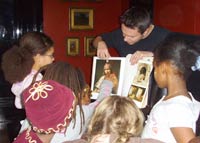Classroom activities
 Key Stage 1&2:
Key Stage 1&2: Art and Design
Investigating Materials (Unit 1b)
Can Buildings Speak (Unit 2c)
Investigating Pattern (Unit 3b)
Citizenship
Living in a Diverse World
(Unit 5)
 Key Stage 3:
Key Stage 3: Art and Design
What's in a building? (Unit 7b)
Change your style (Unit 9b)
Citizenship
Britain – a diverse society?
(Unit 4)
 Leighton House Webquest (download Word document)
Leighton House Webquest (download Word document) Key Stage 3 History :
What were the achievements
of the Islamic states 600-1600?
(Unit 06)
These ideas for activites can be used as preparation for, or follow up from, a museum visit. Alternatively they can be used in conjunction with a 'whole class virtual tour'. The webquests offer separate activities and can be used alongside these activities.Section 5 - What can we learn from
the architecture of Islamic civilizations?
Many people today think that Muslim culture is uniform and intimately bound up with religion. This is not the case. The reality is that much of Muslim art, architecture and design is secular based and serves non-religious purposes. Architecture is an excellent example to illustrate this point. Aim: To get pupils to understand that the architecture of the Muslim world was and is diverse and has multiple uses.
Method: Contrasting a mosque interior with the non-religious Arab Hall at Leighton House Museum.
Resources: Virtual tour of Arab Hall, information contained within 'Leighton and collecting' on our website, photographs of mosque interiors.
Activities
1) Familiarise yourself with the debate on visual representation in Islam by looking at the essay What is Islamic Art? in our 'Leighton and Collecting' section on our website.2) In order to explore the non-religious nature of Leighton's Arab Hall it is first useful for your pupils to understand the religious nature of the mosque. Use photographs of mosque interiors to explain to pupils the following:
Why there is no figurative images within the mosque?
. Why calligraphy dominates the interior decoration of mosques?
. Why coloured and stained glass (non-representational) is used?
. Why are the following words important in religious architecture - mihrab, minbar, quibla? (see our Glossary for explanation)
3) Now access the virtual tour of the Arab Hall to explore a non-religious interior with your pupils. Leighton's Arab Hall is a re-imagining of many of the spectacular interiors he saw on his journeys in the Middle East. Leighton did not intend it to be a direct imitation of one place in particular but rather a room that had many influences.
4) Navigate through the numbered 'hotspots' to see how both figurative and non-figurative elements were used in Muslim buildings throughout the centuries.
5) Use 'hotspots' 1, 2 & 9 with your pupils to discuss how people within religions and cultures can have contrasting opinions on the use of images. This point could be tied in with Citizenship Unit 13; How do we deal with conflict?
What we offer:
 Costumed actress-led sessions
Costumed actress-led sessions
 Storytelling sessions
Storytelling sessions
 Visit preparation and follow-up work
Visit preparation and follow-up work
Making a booking:
 Schools' booking form (download Word document)
Schools' booking form (download Word document)

 Risk Assesment form
Risk Assesment form
(download Word document)

 Costumed actress-led sessions
Costumed actress-led sessions Storytelling sessions
Storytelling sessions Visit preparation and follow-up work
Visit preparation and follow-up workMaking a booking:
 Schools' booking form (download Word document)
Schools' booking form (download Word document) Risk Assesment form
Risk Assesment form (download Word document)


